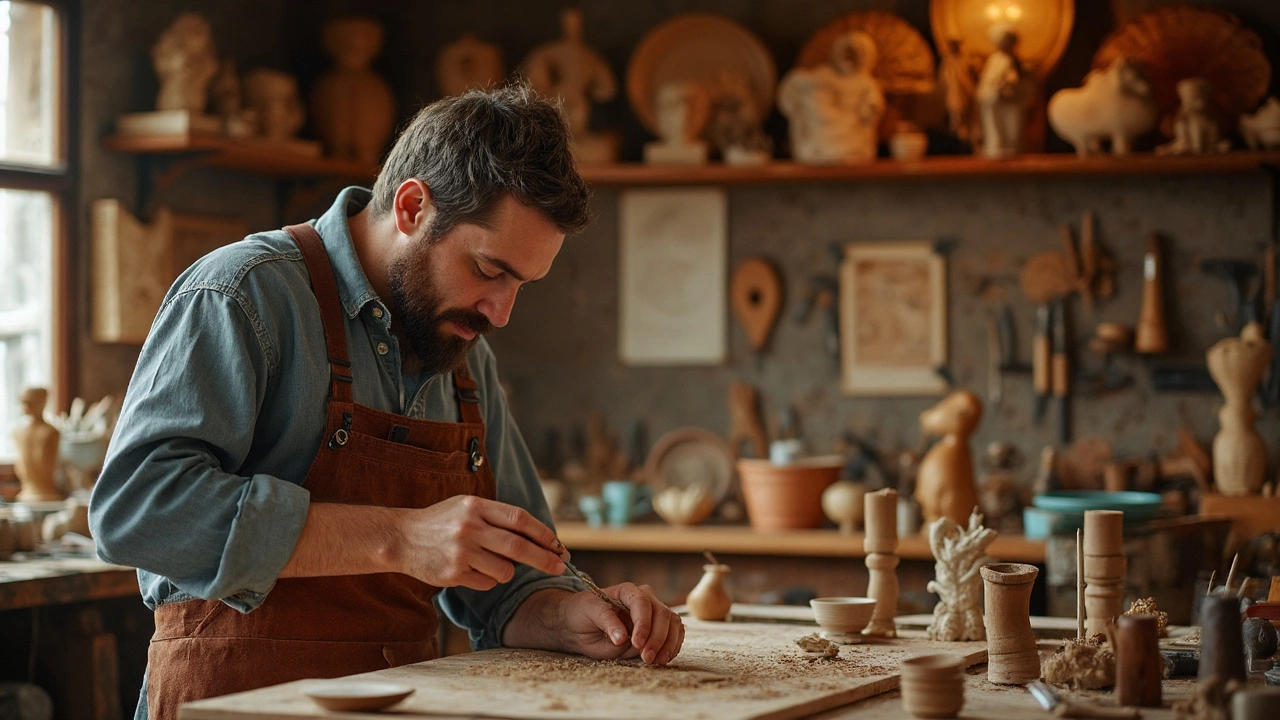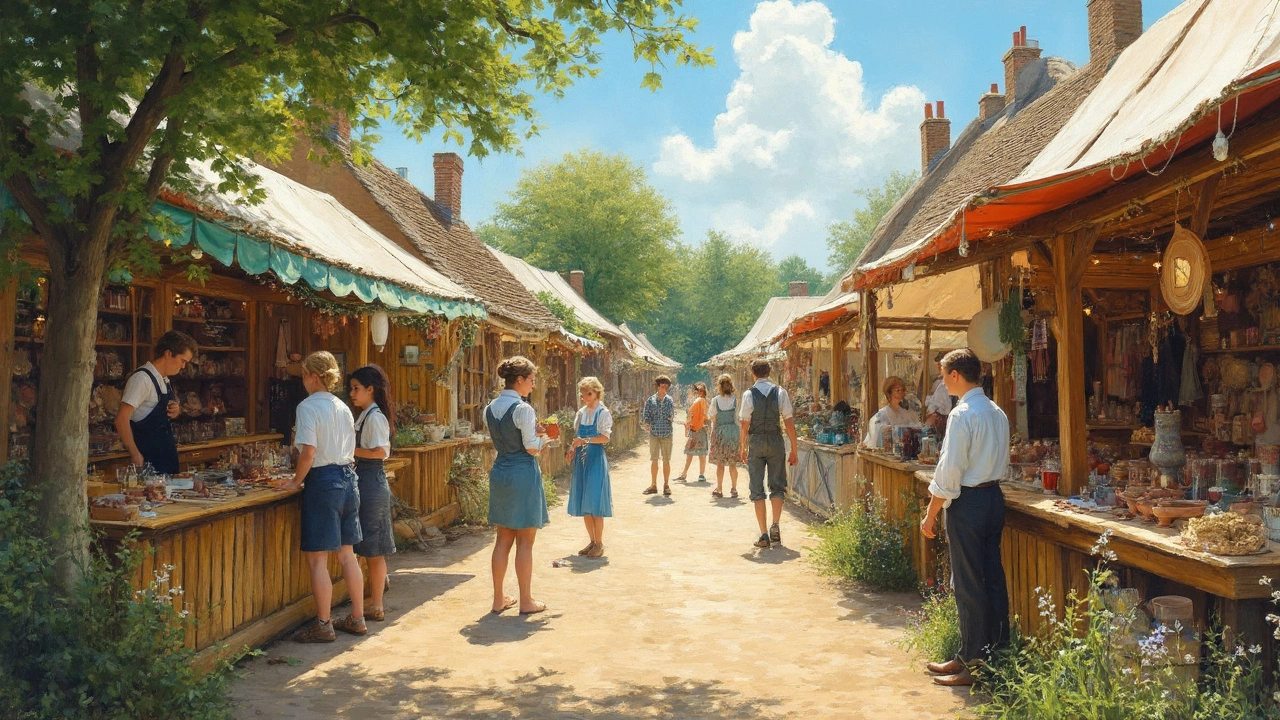Reviving the American Craftsman: A Journey into Heritage
 Mar, 31 2025
Mar, 31 2025
Ever thought about why everyone's suddenly talking about the allure of handmade items? It's not just about nostalgia. There's something special about knowing that a piece you own was crafted with real skill and care. The American Craftsman movement isn't just bringing back old techniques; it's about appreciating the depth and richness of these crafts. It's a cultural shift toward valuing what takes time, patience, and artistry.
These days, more people are looking to embrace this shift. They're attending local craft fairs and taking up hobbies like woodworking or textiles—to reconnect with this meaningful tradition. What's cool is how these crafts come with no rules other than authenticity. As people crave more genuine connections in their busy lives, crafts provide a tangible link to the past. And that, in a world of speeding towards digital everything, feels pretty refreshing.
The blend of heritage and innovation is really at the core of this revival. Today's artisans are mixing traditional methods with modern ideas, creating pieces that are both rooted in history and strikingly contemporary. It's this mix that makes the American Craftsman movement so dynamic and exciting right now.
- Discovering the Craftsman Spirit
- The Role of Community in Craft Revival
- Modern Innovations in Heritage Arts
- Learning from Master Craftsmen
- Integrating Craftsmanship into Everyday Life
Discovering the Craftsman Spirit
When we talk about the American Craftsman movement, we're diving into a world rich with history and personality. This movement hit its stride in the late 19th and early 20th centuries, as a response to the Industrial Revolution. People were tired of cold, mass-produced goods, and there was a growing demand for items that were made with care and skill.
The Craftsman Spirit is all about valuing the process of making. It's where human touch and creativity come together to produce something truly unique. At the heart of it, though, is a mindset that appreciates quality, authenticity, and the beauty of imperfection. It's no wonder this approach is gaining momentum today, where everything seems disposable.
Today, more folks are getting interested in artisan work. We see this in the booming popularity of maker spaces and community workshops. Think of them as modern-day gathering spots where experienced craftsmen and eager learners share space and ideas.
Interestingly, the resurgence isn't just happening in urban areas. It's also popping up in small towns, where local artisans find inspiration from their surroundings and traditions. Here, crafts become a way of preserving local heritage while fostering a sense of community.
Some easy ways to jump into this movement include visiting local craft fairs, supporting small businesses that focus on handmade goods, or even picking up a new craft hobby yourself. Whether it's woodworking, quilting, or pottery, the journey can be incredibly rewarding.
No need to feel overwhelmed—start with simple projects and build your skills from there. With most folks always on their devices, creating something with your own two hands can be the perfect escape. Plus, you'll end up with unique items that you can cherish for years.
The Role of Community in Craft Revival
When you think about American craftsman and what's making it come alive again, community is a big deal. People aren't just getting into crafts alone in their garages – there's a whole social vibe to it. Folks are gathering at local workshops and maker fairs, fueling a movement that’s as much about social connection as it is about the crafts themselves.
Look at how local arts councils and craft guilds are stepping up. They’re not just preserving traditional crafts; they’re making them accessible. By hosting events and classes, they help people get hands-on experience, which is critical for passing on those time-honored skills. It's like when you go to a pottery class, you're not just learning to shape clay—you're becoming part of a community that shares stories, tips, and encouragement.
Plus, this revival isn't just limited to small towns or artist hubs anymore. Urban areas are bursting with co-working craft spaces where people can share tools and inspiration. This means the barrier to entry is lower because you don’t need to buy a whole bunch of expensive equipment to get started.
- Heritage and community centers are the unsung heroes here, making sure old techniques don't vanish with the past generation.
- Shared art studios let strangers become friends over a loomed piece or a wood-fired mug—fusions of creativity and camaraderie.
What’s really awesome is how modern technology is playing into this community aspect, too. Online platforms and social media are allowing these small communities to reach global audiences. An indie woodworker in Minnesota can share tutorials with someone thousands of miles away, making the spirit of craftsmanship not just American but worldwide.
All of this shows that reviving crafts isn't just about the act itself; it’s a collective experience. It's about finding your tribe, sharing what you love, and, in the process, keeping something timeless alive.

Modern Innovations in Heritage Arts
Imagine blending the charm of old-world craft with the cleverness of modern tech. That's exactly what's happening in the world of American craftsman today. Artisans are stepping up their game using digital tools and tech, revolutionizing the way we see traditional crafts.
Take, for example, 3D printing—an innovation that's making waves in heritage arts. While it sounds super high-tech, it’s being used to create molds that replicate antique patterns with insane precision. And it doesn’t stop there. 3D technology helps in crafting intricate designs that were once super difficult to achieve by hand.
Then there's the wonder of old-new collaborations. Picture an experienced craftsman partnering with a tech-savvy artist. This mix of skill sets leads to creations that respect tradition but also feel fresh and new. These collaborations aren't just exploring what can be done; they’re opening doors to what might have felt impossible a few years ago.
Even social media has a hand in this revival. Platforms like Instagram and Etsy are invaluable for artisans looking to reach a wider audience. They're sharing not just their creations but also the story behind each piece, which resonates with folks seeking more meaningful connections with their purchases. It’s like bringing the art gallery to your phone, offering worldwide exposure that was once just a dream for many artisans.
On the practical side, technology is helping artisans improve efficiency while keeping quality in check. Specialized software aids in pattern-making and precision cutting, allowing craftspeople to spend more time on the creative side rather than getting bogged down by tedious manual tasks. The end result—products that are not only beautiful but also consistent in quality.
Technology and heritage might seem like an unlikely pair, but they're proving to be quite the team. The revival of heritage arts isn't about replacing the old with the new; it's about enhancing what already exists and taking it to new and exciting levels. This fusion of the past and future ensures the arts remain relevant, relatable, and absolutely captivating.
Learning from Master Craftsmen
Ever tried to learn a new skill and felt frustrated? That's where learning from master craftsmen can totally change the game. These folks aren't just experts because they've been doing it forever—they have insights you won't find in a book or tutorial. And trust me, they love sharing what they know with those genuinely interested.
Spending time with a master craftsman is like gaining VIP access to centuries of techniques and trade secrets. Many craftsmen, whether in woodworking, pottery, or textile arts, offer workshops or apprenticeships. These experiences are super hands-on, providing real-world applications you just can't get from online videos. Plus, they offer guidance tailored to your progress, which can be a game changer.
For example, in woodturning, nuanced techniques passed down through generations can hugely improve your skills. Small local studios often host classes or weekend workshops where masters teach not just skills but the 'why' behind each step, which deepens your understanding of craftsmanship. Imagine knowing not just how to carve a chair but hearing about the right wood choice and why a particular tool angle works better.
Data from the Craft Retailer Association shows that around 40% of artisan craft learners prefer face-to-face sessions for this exact reason—it's all about the personal connection and real-time feedback.
So, if you're ready to jump in, look for community classes or events that feature renowned artisans. You could also reach out directly to craftsmen you admire—many are open to mentoring enthusiasts. Not only could you gain some killer skills, but you’d also get to pass on the love of these heritage arts, ensuring their legacy for the next generation.

Integrating Craftsmanship into Everyday Life
So, you're considering bringing a touch of that American craftsman magic into your daily grind? Awesome choice. It's not just about owning a piece of crafted art; it's about letting that spirit shape how you live. Let's dive into concrete ways to make craftsmanship a regular part of life.
You can start by bringing handcrafted items into your home. Think about swapping out mass-produced decor for unique handmade pottery or artisanal textiles. Each piece tells a story, adding not just aesthetic value but a personal connection to the makers behind them. It's like filling your space with warmth and character.
Swapping skills is another cool trick. Join local craft workshops. Be it woodworking, pottery, or even weaving, these classes are fun and offer hands-on ways to learn. Plus, they aren’t just about becoming a craft master overnight—they’re about enjoying the process and being part of a community.
If you're more of a DIY person, try upcycling. It's super eco-friendly and adds a personalized touch to your stuff. Grab an old chair or lamp, give it some love with paint or fabric, and bam, you’ve created something new that reflects both past and present styles.
- Start with simple projects, like repainting an old piece of furniture.
- Join online forums or local groups to share tips and find inspiration.
- Visit local markets to understand what's trending and see other artisans' work.
For those wondering about the environmental impact of all this, getting into crafts is surprisingly green. By valuing sustainable materials and methods, you're basically becoming an eco-hero. It's about less waste, more creativity, and keeping those traditional skills alive.
Integrating craftsmanship isn’t just for weekends or specific events; it's a lifestyle shift. As you start to embrace this, you’ll notice a newfound appreciation for the little details, a meaningful connection to history, and an endless playground for creativity. Dive in and watch how these crafts enhance your everyday life in unexpectedly delightful ways.